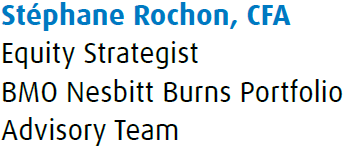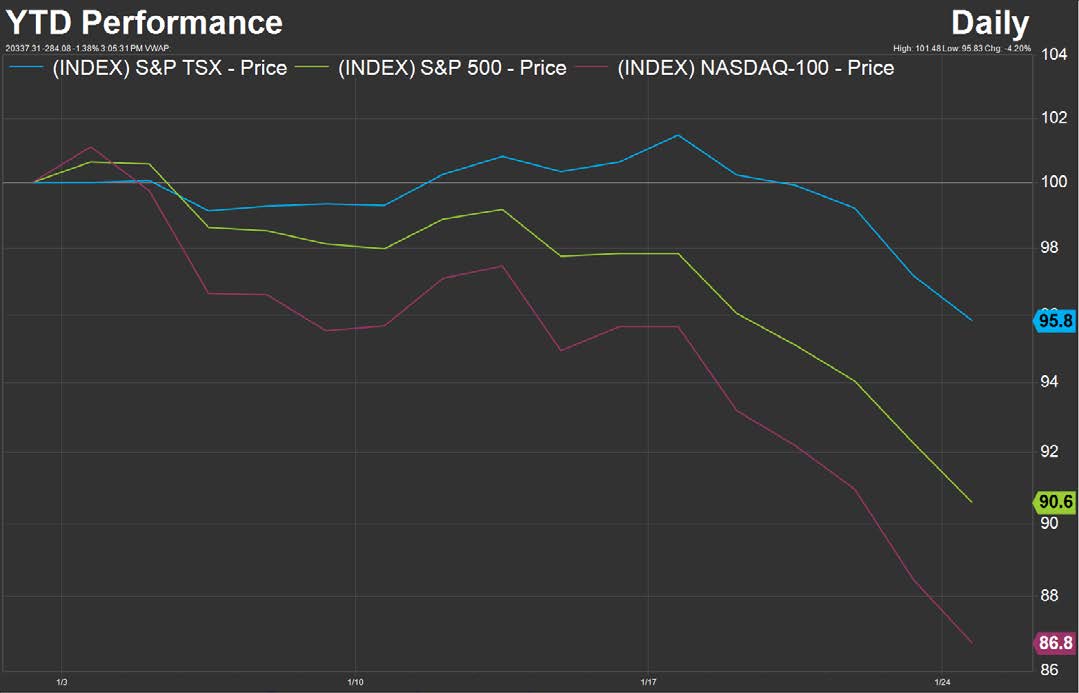

The world of investments has no shortage of adages and aphorisms meant to simplify and distill centuries of market observations. “Stocks grind up and gap down” and “valuations do not matter until they do,” immediately come to mind as we ponder the market action so far this year.
After an extremely strong 2021, the new year has started off with significant volatility. In our opinion, this has everything to do with rising inflation and associated higher interest rates (more on this below). Yes, Omicron has taken the world by storm and there is considerable tension on the Ukrainian border, but we do not think these factors are really moving the “market needle” at this point. On Omicron in particular, a rising number of experts believe that we are at, or past the peak of infections in many regions (including in North America) and that COVID-19 could morph into something more akin to a bad flu (more infectious but less severe). We happen to share this view.
Market action seems to support this opinion as we take a step back to analyse the nature of the pullback so far. There has been a very wide variance in performance across different sectors. Year-to-date the S&P/TSX the S&P/TSX is down less than 4%, the S&P 500 has corrected about double that, the tech-heavy Nasdaq 100 is down 12%, Bitcoin is off 21%, and Canadian tech success story Shopify has declined a full 33%. High multiple stocks (especially unprofitable technology companies and crypto plays) have taken the greatest hit.

Valuations Matter Again
As we wrote at the beginning of December 2021: “Looking at valuations for stocks – or other asset classes for that matter – is a terrible timing tool. However, financial history has proven time and time again that being disciplined about the price paid for assets (having a “margin of safety” as Warren Buffet famously put it) is the best way to ensure an appropriate return for long-term investors. This principle applies as much to real estate as it does for financial assets such as bonds and stocks. The principal reason for this is that the stock market is inherently mean reverting, meaning that excesses to the upside or downside tend to be corrected with opposite reactions (think of an elastic which is pulled too far and then snaps in the opposite direction).
The Impact of Inflation and Interest Rates
Higher inflation erodes purchasing power and pushes interest rates higher because central banks are forced to tighten monetary conditions to prevent inflation from spiraling out of control as we witnessed in the 1970s. This, in turn, lowers the present value of future corporate free cash flows (which is, in essence, the fair value for stocks).The more investors believe these cash flows will grow in the future, the more those stocks are negatively impacted by this effect. Our work a few months back showed that foran increase in the assumed long-term bond rate of just 1%, it will reduce the fair value for certain very high multiple stocks by 10- 20%. The silver lining at this point is that some stocks have corrected far more than this which opens up opportunities to find high-quality names that have been overly punished.
We believe the growing concern about inflation in the market was first driven by supply chain constraints (which continue to be severe) and is now being exacerbated by labor shortages which are pushing up wages. Historically, excessive interest rate increases have reduced economic growth and have eventually led to recessions. We hasten to add; however, that it is very unlikely we will see this in the short term since monetary policy impacts the real economy with a considerable lag. In other words, even if the Bank of Canada and the U.S. Federal Reserve raise rates this week, it will only have an economic impact 12 to 18 months from now.
Importantly, BMO’s Chief Economist Doug Porter, recently stated that while the timing and pace of the initial rate moves are interesting debates, the much bigger question is: To bring inflation to heel, how much will both need to tighten? At this point, we still believe that a combination of relatively speedy rate action, some calming in energy prices, and an improvement in supply chain issues suggest that ultimately, central banks will not go much further than the neutral rate (i.e., around 2%) to calm the inflation waters. Moreover, arguably both would be willing to tolerate inflation a bit above 2% later on in the cycle, since it could potentially fall hard in the next downturn.
In an inflationary environment, companies with pricing power (i.e., the ability to pass on price increases to their customers) will be better able to protect their profit margins, thereby offering a measure of protection to their share price. There are still many tech stocks with huge competitive advantages which fit that criterion.
Market Technicals
Our Technical Analyst Russ Visch, notes that when the market is in a long-term uptrend there are two types of pullbacks: short-term; and medium-term. Short-term pullbacks are relatively inconsequential, lasting about 2 to 3 weeks and tend to stop at/near the rising 50-day moving average.
Medium-term pullbacks are more pronounced and prolonged and tend to bring a security back to – and sometimes slightly underneath – its rising 200-day moving average over a 2 to 4-month period. These tests of the 200-day moving average are the best spot to buy stocks in long-term uptrends. While U.S. equity markets have come under a great deal of pressure over the past two weeks, both the S&P 500 and Nasdaq Composite appear to be completing normal, medium-term pullbacks since both indexes ended the week slightly below their rising 200-day moving averages. At the same time, all of our daily breadth and momentum oscillators are stretched into oversold extremes, and sentiment is overly pessimistic. In fact, some of these indicators are now stretched to levels not seen since the bear market low in March of 2020 (i.e., all of the conditional elements are now in place for a trading low to develop any time now).
While the environment could remain volatile for some time and more downside is certainly possible, the key is to stay disciplined about the price paid for any assets and to maintain a well-diversified portfolio, including cash, bonds, and high-quality stocks.
Please contact your BMO financial professional if you would like to discuss your investment portfolio.
General Disclosure
The information and opinions in this report were prepared by BMO Nesbitt Burns Inc. Portfolio Advisory Team (“BMO Nesbitt Burns”). This publication is protected by copyright laws. Views or opinions expressed herein may differ from the views and opinions expressed by BMO Capital Markets’ Research Department. No part of this publication or its contents may be copied, downloaded, stored in a retrieval system, further transmitted, or otherwise reproduced, stored, disseminated, transferred or used, in any form or by any means by any third parties, except with the prior written permission of BMO Nesbitt Burns. Any further disclosure or use, distribution, dissemination or copying of this publication, message or any attachment is strictly prohibited. If you have received this report in error, please notify the sender immediately and delete or destroy this report without reading, copying or forwarding. The opinions, estimates and projections contained in this report are those of BMO Nesbitt Burns as of the date of this report and are subject to change without notice. BMO Nesbitt Burns endeavours to ensure that the contents have been compiled or derived from sources that we believe are reliable and contain information and opinions that are accurate and complete. However, BMO Nesbitt Burns makes no representation or warranty, express or implied, in respect thereof, takes no responsibility for any errors and omissions contained herein and accepts no liability whatsoever for any loss arising from any use of, or reliance on, this report or its contents. Information may be available to BMO Nesbitt Burns or its affiliates that is not reflected in this report. This report is not to be construed as an offer to sell or solicitation of an offer to buy or sell any security. BMO Nesbitt Burns or its affiliates will buy from or sell to customers the securities of issuers mentioned in this report on a principal basis. BMO Nesbitt Burns, its affiliates, officers, directors or employees may have a long or short position in the securities discussed herein, related securities or in options, futures or other derivative instruments based thereon. BMO Nesbitt Burns or its affiliates may act as financial advisor and/or underwriter for the issuers mentioned herein and may receive remuneration for same. Bank of Montreal or its affiliates (“BMO”) has lending arrangements with, or provides other remunerated services to, many issuers covered by BMO Nesbitt Burns’ Portfolio Advisory Team. A significant lending relationship may exist between BMO and certain of the issuers mentioned herein. BMO Nesbitt Burns Inc. is a wholly owned subsidiary of Bank of Montreal. Dissemination of Reports: BMO Nesbitt Burns Portfolio Advisory Team’s reports are made widely available at the same time to all BMO Nesbitt Burns investment advisors. Additional Matters TO U.S. RESIDENTS: Any U.S. person wishing to effect transactions in any security discussed herein should do so through BMO Capital Markets Corp. (“BMO CM”) and/or BMO Nesbitt Burns Securities Ltd. (“BMO NBSL”) TO U.K. RESIDENTS: The contents hereof are intended solely for the use of, and may only be issued or passed onto, persons described in part VI of the Financial Services and Markets Act 2000 (Financial Promotion) Order 2001. BMO Wealth Management is the brand name for a business group consisting of Bank of Montreal and certain of its affiliates, including BMO Nesbitt Burns Inc., in providing wealth management products and services.
BMO CM and BMO NBSL are Members of SIPC. ® BMO and the roundel symbol are registered trade-marks of Bank of Montreal, used under license. ® “Nesbitt Burns” is a registered trade-mark of BMO Nesbitt Burns Inc. If you are already a client of BMO Nesbitt Burns, please contact your Investment Advisor for more information.
BMO Private Wealth is a brand name for a business group consisting of Bank of Montreal and certain of its affiliates in providing private wealth management products and services. Not all products and services are offered by all legal entities within BMO Private Wealth. Banking services are offered through Bank of Montreal. Investment management, wealth planning, tax planning, and philanthropy planning services are offered through BMO Nesbitt Burns Inc. and BMO Private Investment Counsel Inc. Estate, trust, and custodial services are offered through BMO Trust Company. Insurance services and products are offered through BMO Estate Insurance Advisory Services Inc., a wholly-owned subsidiary of BMO Nesbitt Burns Inc. BMO Private Wealth legal entities do not offer tax advice. BMO Nesbitt Burns Inc. is a member of the Canadian Investor Protection Fund and the Investment Industry Regulatory Organization of Canada. BMO Trust Company and BMO Bank of Montreal are Members of CDIC.
® Registered trademark of Bank of Montreal, used under license.